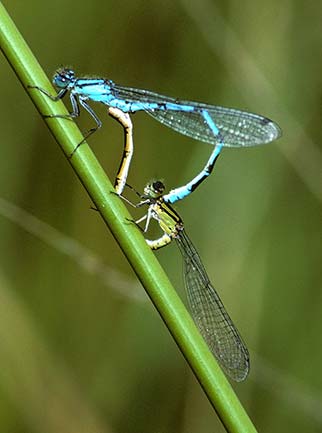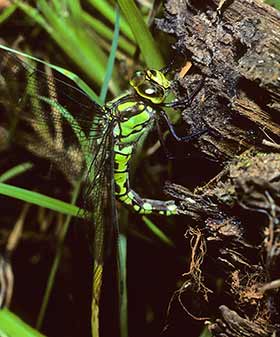Dragonflies and damselflies - mating, egg laying and aquatic life

Dragonflies and damselflies have fascinatingly complex life cycles.
The often multi-coloured winged insects seen in spring and summer represent the final, adult stage of the cycle, designed essentially for mating. Earlier stages are aquatic, played out underwater for between a few months and a number of years, depending on the species, water and weather conditions.
But first, let’s look at mating and egg laying.
Dragonflies and damselflies have the most peculiar mating system. Male dragonflies transfer sperm from a genital opening close to the tip of their abdomen - the long, often slender ‘tail’ - to an accessory organ closer to the body, or thorax as it is more properly known.
This done, a female is located and the male uses his claspers, specially designed appendages at the tip of the abdomen, to unceremoniously grab her by what appears to be the scruff of the neck but is, in fact, a part of the body known as the prothorax.
Damselflies adopt a similar process, although they transfer the sperm after the female has been ‘clasped’.
If receptive, she swings her genital opening, situated towards the tip of the abdomen underside, into contact with the male’s accessory organ, and sperm is transferred, sometimes in flight, sometimes at rest, whilst both are in this circular, wheel-like position.

in or beside a piece of rotted
water-side wood
Courtship rituals are often difficult to spot, and mating certainly doesn’t appear to be a gentlemanly process, although survival of the species from pre-historic times suggests a high degree of effectiveness.
Eggs are always laid in or around water.
Whilst still in flight, females of some species simply jettison their eggs over the water, whilst others dip in their abdomen. A number partially or fully submerge, clambering down stems of aquatic vegetation, often with the male nearby or still connected in the ‘wheel’ position. The more sedate, though, lay into floating vegetation or other suitable material at the water’s edge.
The eggs hatch, often within a few weeks, to reveal from each a tiny prolarva. This grows rapidly, repeatedly casting its skin until as a fully grown larva it is ready to emerge into the open air as a winged adult.
Whilst underwater, they are ferocious beasts, initially taking only tiny aquatic creatures, but eventually often able to tackle small fish and tadpoles.
Hunting methods vary. Some live in the weeds and actively chase down prey, whilst others are bottom-dwellers that hide in the mud, waiting for passing snacks to come to them.
Time spent underwater varies depending on species, water and weather conditions. Some emerge after two or three months, whilst others, primarily the larger species, may not emerge for a number of years.
References:
A Guide to the Dragonflies of Great Britain: Dan Powell
Dragonflies and Damselflies of Britain and Northern Europe: Bob Gibbons
More links
Other related links
Search this site

Sadly, 58 animals were killed - 35 ponies, 13 cows, 8 donkeys and 2 sheep, whilst a further 32 were injured - 3 pigs, 9 donkeys, 11 cows and 9 ponies.
(Forty-three accidents occurred in daylight, 15 at twilight and 101 in the dark. Twenty-seven accidents were not reported by the driver involved).
Here's just one horrific example - Three donkeys killed in collision with van at notorious New Forest blackspot (Advertiser and Times)

